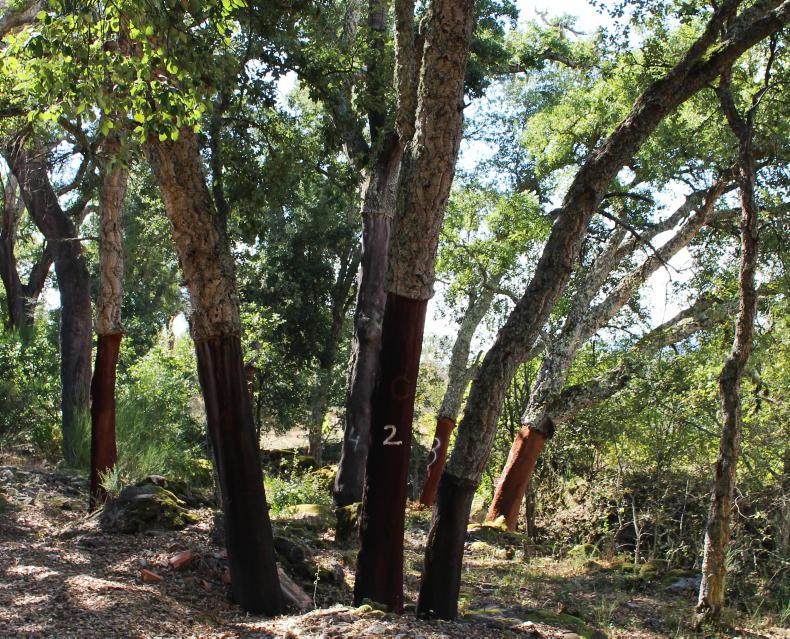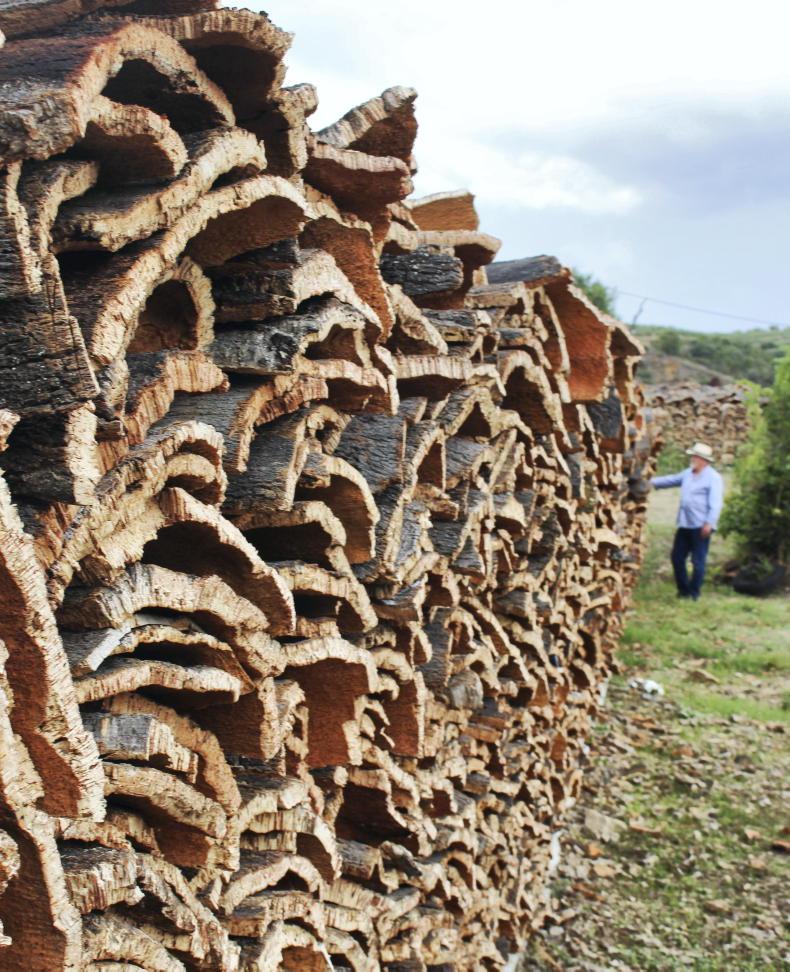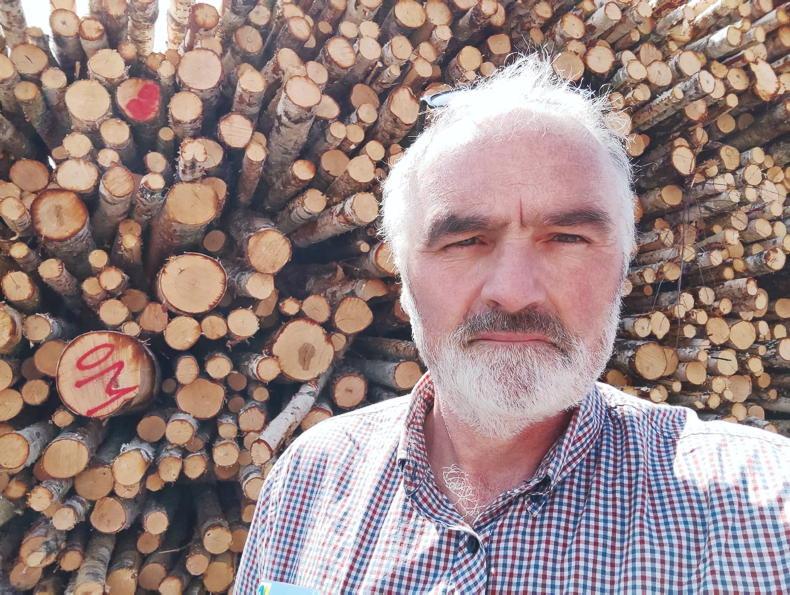No matter how bad Irish forest fires are, they never cover large areas like those experienced elsewhere in Europe. This is due to the fragmented nature of Irish forests, and also because we rarely experience drought conditions.
This is in contrast to Portugal, where global warming is now a reality resulting in large-scale forest fires and drought conditions that are changing land use in agriculture and forestry.
You don’t have to travel very far in Portugal to notice the damage by forest fires.
On the face of it, it shouldn’t be a problem, as annual average precipitation (1,000mm) is not much lower than in Ireland (1,230mm).
But, unlike Ireland, Portugal’s rainfall is unevenly spread, with drought spells that can last for months often followed by heavy rainfall and flooding over short periods.
Global warming effects
The topic of global warming dominated a recent study tour by the Society of Irish Foresters (SIF) in southwest Portugal, around the Bragança.
The tour began with a presentation by João Azevedo and José Castro, lecturers at the city’s Polytechnic Institute. Azevedo, who is also vice-president of the Portuguese Society of Forestry Sciences, outlined how foresters are facing up to this challenge.
Castro, who acted as the tour guide, discussed changing forestry and land use practices, including tree species selection. “We have to adapt our forests to new circumstances,” he said.
He explained that the irregular patterns of precipitation mean that it is essential to store water during heavy rainfall to provide irrigation for crop production, including wineries, olive farms and especially the country’s increasing number of sweet chestnut (Castanea sativa) orchards.
As a result, dam-building is necessary – and costly – aspect of crop management, where irrigation is required during prolonged drought.
The main species in Portugal’s diverse 3.4m ha of forests are pine (predominantly P. pinaster), eucalyptus (mainly E. globulus) and oak, dominated by cork oak (Quercus suber).

The numbers on the cork oak trees represent the final digit of harvest year, so the tree in the foreground had its bark removed in 2022. \ Donal Magner
While travelling from Bragança southwest to Romeu, the scale and diversity of trees and forests is apparent. Sweet chestnut orchards are ever present on the lower slopes, while Pyrenean oak (Quercus pyrenaica) dominates the distant mountains.
Although, sweet chestnut is grown in France and other Mediterranean countries as a quality timber tree, in Portugal, it is valued for nut production.
The chestnut orchards are similar to what Ireland might expect from agroforestry, except they carry lower densities of tree cover, usually less than 200/ha. The abundant nut-producing orchards can be combined with other land uses, including cereals and mushrooms.
As we reach the village of Romeu, the chestnut orchards give way to wineries and olive farms and, eventually, cork oak forests.
Cork oak production
Most global cork oak harvesting is in southern Europe and North Africa, with Portugal dominating production, explains Vitor Manuel Vasco, who manages a 500ha cork oak forest outside the village.
Vitor outlines the procedures involved in harvesting cork. “The harvesting methods have changed little over the centuries, as skilled workers remove the bark with axes,” he says.

Vitor Manuel Vasco inspects the ‘cork wall’ before the bark is transported to the cork manufacturing factory. \ Donal Magner
They ensure that the cambium layer under the bark is not damaged during harvesting and that trees are not overharvested, so that successive cork layers can form to allow future harvesting during the lifespan of a tree for over 150 years.
The forest is rich in ground vegetation and while the trees are healthy and well managed, production has been reduced over the years because of climate change.
“Instead of removing the bark on seven-year cycles, growth has slowed down due to prolonged drought periods,” Vitor explains. “Now the bark is harvested every 10 years.”
Production can begin as early as year 25, when virgin cork is stripped, but good-quality cork oak production begins when trees reach 40 years and continues for a further 120 to 160 years.
Trees produce the cork when their breast height diameter (dbh) is approximately 70cm or greater.
The onsite price of good-quality cork is €40 per 15kg batch (€2,700/tonne). The bark is stored locally before it is transported to the cork manufacturing factories.
Vitor has a staff of 10 who harvest the bark from mid-May to August. It is just one operation that sustains the community throughout the year in the Romeu area.
In addition to cork harvesting, the area also includes wine, nut and olive farming.
Shift to non-wood
There is a distinct impression that forest use is shifting from wood to non-wood products and services in Portugal, which is accelerated by global warming.
In a country experiencing water shortages, the afforestation of the highly productive but water-demanding eucalyptus is being restricted in some regions.
Next week: pine and oak in forest, former farmland and cooperage.
Northeast forest owners focus on group certification
The North East Forestry Group (NEFG) will host a number of Knowledge Transfer Group (KTG) events focusing on group certification in January.
“These events will help participants to get the best return from their forests,” said Derek McCabe, chair NEFG.
“The programme is funded by the Department of Agriculture, Food and the Marine, and is open to forest owners in Counties Cavan, Louth, Meath and Monaghan,” he explained.

Derek McCabe, chair NEFG.
“Not only will good forest management practices be highlighted, but the processes involved in achieving forest certification will also be outlined.”
Forest certification is provided to forest owners who can prove to an independent certification body that their forests are managed according to the principles of sustainable forest management (SFM).
Participants will be paid €70 for each of the seven events attended.
The KTG is open to forest owners who have not taken part in courses in the previous three years. “The good news is that the NEFG is opening the KTG programme to both existing and prospective new members on a first come, first served basis,” said McCabe.
Participants are advised to book early, as registration will close as soon as the programme is fully subscribed.
No matter how bad Irish forest fires are, they never cover large areas like those experienced elsewhere in Europe. This is due to the fragmented nature of Irish forests, and also because we rarely experience drought conditions.
This is in contrast to Portugal, where global warming is now a reality resulting in large-scale forest fires and drought conditions that are changing land use in agriculture and forestry.
You don’t have to travel very far in Portugal to notice the damage by forest fires.
On the face of it, it shouldn’t be a problem, as annual average precipitation (1,000mm) is not much lower than in Ireland (1,230mm).
But, unlike Ireland, Portugal’s rainfall is unevenly spread, with drought spells that can last for months often followed by heavy rainfall and flooding over short periods.
Global warming effects
The topic of global warming dominated a recent study tour by the Society of Irish Foresters (SIF) in southwest Portugal, around the Bragança.
The tour began with a presentation by João Azevedo and José Castro, lecturers at the city’s Polytechnic Institute. Azevedo, who is also vice-president of the Portuguese Society of Forestry Sciences, outlined how foresters are facing up to this challenge.
Castro, who acted as the tour guide, discussed changing forestry and land use practices, including tree species selection. “We have to adapt our forests to new circumstances,” he said.
He explained that the irregular patterns of precipitation mean that it is essential to store water during heavy rainfall to provide irrigation for crop production, including wineries, olive farms and especially the country’s increasing number of sweet chestnut (Castanea sativa) orchards.
As a result, dam-building is necessary – and costly – aspect of crop management, where irrigation is required during prolonged drought.
The main species in Portugal’s diverse 3.4m ha of forests are pine (predominantly P. pinaster), eucalyptus (mainly E. globulus) and oak, dominated by cork oak (Quercus suber).

The numbers on the cork oak trees represent the final digit of harvest year, so the tree in the foreground had its bark removed in 2022. \ Donal Magner
While travelling from Bragança southwest to Romeu, the scale and diversity of trees and forests is apparent. Sweet chestnut orchards are ever present on the lower slopes, while Pyrenean oak (Quercus pyrenaica) dominates the distant mountains.
Although, sweet chestnut is grown in France and other Mediterranean countries as a quality timber tree, in Portugal, it is valued for nut production.
The chestnut orchards are similar to what Ireland might expect from agroforestry, except they carry lower densities of tree cover, usually less than 200/ha. The abundant nut-producing orchards can be combined with other land uses, including cereals and mushrooms.
As we reach the village of Romeu, the chestnut orchards give way to wineries and olive farms and, eventually, cork oak forests.
Cork oak production
Most global cork oak harvesting is in southern Europe and North Africa, with Portugal dominating production, explains Vitor Manuel Vasco, who manages a 500ha cork oak forest outside the village.
Vitor outlines the procedures involved in harvesting cork. “The harvesting methods have changed little over the centuries, as skilled workers remove the bark with axes,” he says.

Vitor Manuel Vasco inspects the ‘cork wall’ before the bark is transported to the cork manufacturing factory. \ Donal Magner
They ensure that the cambium layer under the bark is not damaged during harvesting and that trees are not overharvested, so that successive cork layers can form to allow future harvesting during the lifespan of a tree for over 150 years.
The forest is rich in ground vegetation and while the trees are healthy and well managed, production has been reduced over the years because of climate change.
“Instead of removing the bark on seven-year cycles, growth has slowed down due to prolonged drought periods,” Vitor explains. “Now the bark is harvested every 10 years.”
Production can begin as early as year 25, when virgin cork is stripped, but good-quality cork oak production begins when trees reach 40 years and continues for a further 120 to 160 years.
Trees produce the cork when their breast height diameter (dbh) is approximately 70cm or greater.
The onsite price of good-quality cork is €40 per 15kg batch (€2,700/tonne). The bark is stored locally before it is transported to the cork manufacturing factories.
Vitor has a staff of 10 who harvest the bark from mid-May to August. It is just one operation that sustains the community throughout the year in the Romeu area.
In addition to cork harvesting, the area also includes wine, nut and olive farming.
Shift to non-wood
There is a distinct impression that forest use is shifting from wood to non-wood products and services in Portugal, which is accelerated by global warming.
In a country experiencing water shortages, the afforestation of the highly productive but water-demanding eucalyptus is being restricted in some regions.
Next week: pine and oak in forest, former farmland and cooperage.
Northeast forest owners focus on group certification
The North East Forestry Group (NEFG) will host a number of Knowledge Transfer Group (KTG) events focusing on group certification in January.
“These events will help participants to get the best return from their forests,” said Derek McCabe, chair NEFG.
“The programme is funded by the Department of Agriculture, Food and the Marine, and is open to forest owners in Counties Cavan, Louth, Meath and Monaghan,” he explained.

Derek McCabe, chair NEFG.
“Not only will good forest management practices be highlighted, but the processes involved in achieving forest certification will also be outlined.”
Forest certification is provided to forest owners who can prove to an independent certification body that their forests are managed according to the principles of sustainable forest management (SFM).
Participants will be paid €70 for each of the seven events attended.
The KTG is open to forest owners who have not taken part in courses in the previous three years. “The good news is that the NEFG is opening the KTG programme to both existing and prospective new members on a first come, first served basis,” said McCabe.
Participants are advised to book early, as registration will close as soon as the programme is fully subscribed.









 This is a subscriber-only article
This is a subscriber-only article











SHARING OPTIONS: